 |
A Column of Catholic Orientation
Pope: The Neocatechumenal Way Is a
‘Special Gift of the Holy Spirit’
Marian T. Horvat, Ph.D.
My friend Jan was following some of the conservative sites from Italy that were dramatically awaiting “the verdict” to be delivered by the Vatican on the controversial Neocatechumenal Way on January 20. On that day, Pope Benedict would meet with thousands of its members in the Paul VI Hall and the Pontifical Council for the Laity would release a decree regarding the movement.
Jan told me she knew something of the controversial liturgical practices and doctrinal aberrations of the Neocatechumenal Way. She specified:
- it denies the sacrificial character of the Mass;
- it rejects transubstantiation;
- and it follows Luther’s teaching on justification.
“The Way (as it is called) is more Lutheran than Catholic,” my friend affirmed. “I am sure that our Holy Father will never give his approval to it. After all, if he is serious about reconciling with Catholic traditionalists, why would he approve this sacrilege? It would be a contradiction.”
I do not share Jan’s opinion on the supposed conservatism of Benedict XVI. So I was not surprised to learn that actually at the January 20 audience the Pope warmly praised the Neocatechumenal Way, calling it “a special gift which the Holy Spirit has given to our times.” He lauded the members for their apostolic zeal, noting their “firm commitment to proclaim the Gospel of the risen Christ,” and urged them to always make sure their "precious work" was in "profound communion with the Apostolic See and the pastors of the local church in which they are inserted." (1)
Among the audience of over 7,000 members were co-founders flamenco guitarist Francis Kiko Argüello and ex-nun Carmen Hernández, as well as five cardinals and 50 Bishops.
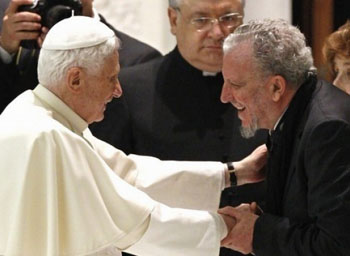
Kiko Arguello thanks the Pope for confirming his movement's celebrations |
Commenting on the decree, which was signed by Cardinal Stanislaw Rylko, president of the Council for the Laity, on January 8 and released on January 20, the Pope affirmed that the Council for the Laity had approved the special celebrations contained in the Catechetical Directory of the Neocatechumenal Way. This declaration implies that he himself approved it. He added that all liturgical celebrations must follow the norms of the Church, but offered no provisos to assure compliance. (2)
In effect, this decree with its papal sanction confirms previous approvals and ends the 15-year Vatican process of examination. In 2008 the Pontifical Council for the Laity sanctioned the Statutes of the Neocatechumenal Way. Its Catechetical Directory – written by Argüello and Hernandez - was approved in 2010, after examination by the Congregation for the Doctrine of the Faith, which inserted cross references to the Catechism of the Catholic Church.
At the end of the January 20 audience, Benedict XVI blessed the 17 new groups of families being sent on mission assignments to three continents. Exiting the papal audience effervescent with joy, Argüello told a Zenit reporter: “We were waiting for this moment, and finally the Church has confirmed the Neocatechumenal Way as a Christian initiation, in its doctrine, liturgy and its stages.”
The movement can now continue on its “new evangelization of the world,” he said in triumph. The dynamism of the new movement is unquestionable; what one can question, however, is whether its liturgy and doctrine are Catholic.
Unorthodox liturgical practices
The liturgy of the Neocatechumenal Way was shaped by Kiko Argüello and Carmen Hernández based, they claim, squarely on the new teachings of Vatican II. It pretends to return to the practices of the early Church, which were allegedly warped and deviated from the true path for centuries until the Council. One of the movement’s early mentors and supporters was none other than Archbishop Annibale Bugnini, the main architect of the New Mass.
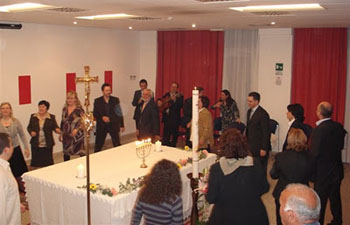
Dancing and singing around the table, a regular part of the Neocatechumenal celebration
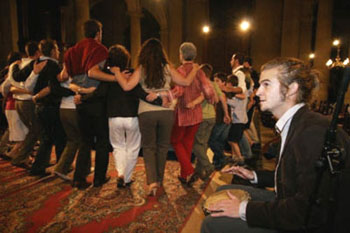 |
Kiko Argüello and Carmen Hernandez say that the original emphasis on the resurrection of Christ in the Mass was lost in the Constantine era and an erroneous sacrificial tone was inserted in its place. Their liturgy calls for paschal exultation at a table, not a sacrifice at an altar.
The members of the Neocatechumenal Way, make their “celebrations” (they do not call them masses) on Saturday night. The small community – ideally no more than 20 or 30 - gathers in chairs around a table (never an altar, which suggests sacrifice) in the center of one of the parish buildings (which they prefer to churches). There they perform their “celebration” sitting and standing, never kneeling or genuflecting. For the Consecration the whole community stands.
Communion is received standing. Each member receives in his hands a piece of the bread broken from a huge loaf – baked by the members themselves according to Argüello’s specific instructions. Then the celebrant sits and waits for all the faithful to receive the bread. After the presbyter says, “Body of Christ, bring us everlasting life,” the whole congregation consumes the loaf together. Then the cup is shared by all. The presbyter is supposed to carry it around, but often the members pass it from hand to hand, to give the sense of eating and drinking around a dinner table.
Since, according to their doctrine, the interpretation of the Word of God is not reserved for the Hierarchy, before the sermon anyone present can give his witness.
Participants dance or process around the table, chanting songs written by Argüello and accompanied by guitar, defined as the instrument “closest to the ancient Hebrew psalter.” There are no hymns or special devotion to Our Lady and the Saints.
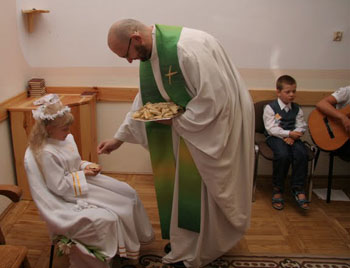
A neocatechumenal first communion, received sitting with no signs of reverence |
Here is a “celebration” in the Philippines, another in Jerusalem and a livelier sample of what goes on in Italy, which is the country with the largest number of neocatechumenal communities.
According to the founders’ thinking, the Passion and Death of Christ plays no role in man’s redemption. Therefore, the Mass is not a renewal of His Sacrifice, and not an altar but a table is where the banquet feast is held. This is quite similar to the Protestant doctrine so dear to Archbishop Bugnini.
Argüello and Hernandez justify all their changes with the “profound renewal of the liturgy that came at Vatican II.” Indeed, many of the neocatechumenal practices are common in Novus Ordo Masses.
Other Protestant-inspired changes
For many years, the teachings of Argüello and Hernandez were kept away from the public. But during the Vatican process of approval, some of their texts were published. These texts, taken from The Neocatecumenate, A Christian Initiative for Adults, (3) clearly reveal the Protestant thinking that inspires the movement:
-
It justifies Luther’s revolt: “It is understandable why Luther emerged making a clean break with everything he believed was a purely human addition or tradition.”
- It promotes Luther’s teaching on justification: “Man is not saved by good works … Jesus Christ did not come to give us a model of life, an example. … The Holy Spirit does not lead us to perfection, to good works … God freely forgives the sins of those who believe that Jesus is the Savior.”
- It rejects transubstantiation: “Luther, who never doubted the real presence of Christ in the eucharist, rejected ‘transubstantiation,’ because it was bound to Aristotelian-Thomistic concept of substance, which is foreign to the Church of the Apostles and the Fathers”
- It rejects the Council of Trent: “The rigidity and fixity of the Council of Trent generated a static mentality in the liturgy, which has persisted to our day.”
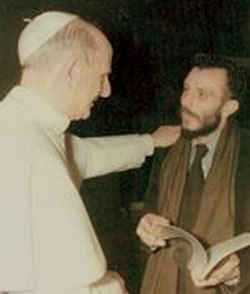
Paul VI: 'The Way' a rich 'fruit of the Council'
|
After a serious study on the Neocatechumenal Way, theologian Fr. Enrico Zoffoli did not hesitate to accuse the movement of being heretical in an article that can be read here.
Fr. Zoffoli also expressed grave concern for the fact that these errors are taught in the 78 Redemptoris Mater seminaries of the Neocatechumenal Way, which have already ordained 12,000 priests in the last 20 years. (4)
Given its Lutheran inspiration and the solid study of Fr. Zoffoli, one can legitimately question whether the “celebrations” of the Neocatechumenal Way are actually valid Masses. Do their priests intend to do what the Church does, offer a propitious sacrifice, when their founders explicitly deny that the Mass is a sacrifice?
Notwithstanding these doctrinal errors, at the recent papal audience, Benedict XVI approved the movement and encouraged its members to continue their work and "offer your original contribution to the cause of the Gospel."
Long history of papal support
Argüello and Hernandez take advantage of every possible opportunity to boast of the constant papal support their movement has enjoyed. The official Neocatechumenal Way website highlights the long line of papal eulogies received since Paul VI in 1977 proclaimed it as a rich “fruit of the Council” while greeting its members.
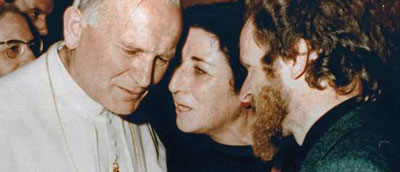
JPII was very close to Carmen Hernandez and Kiko Arguello
|
John Paul II was a strong enthusiast of their “new charism.” He praised it effusively, approved their first seminary in Rome, assisted at meetings and even participated in one of their “celebrations” in Porto San Giorgio in 1989. (5)
As early as 1997, then Card. Ratzinger lauded the movement as a “new model of life” and considered it a “place of true humanity.” (6) When the movement’s statutes were approved in 2010, he praised them as an “ecclesiastical seal for the whole of neocatechumenal teaching.” (7)
As Atila Guimaraes demonstrates in his newly released Animus Injuriandi II, many of the the periti at Vatican II had the intent to prostestantize the Mass and change Church teaching. Joseph Ratzinger was one of those periti. This should explain to my dear Jan why he always favored the Neocatechumenal Way and gave it “final approval” on January 20.
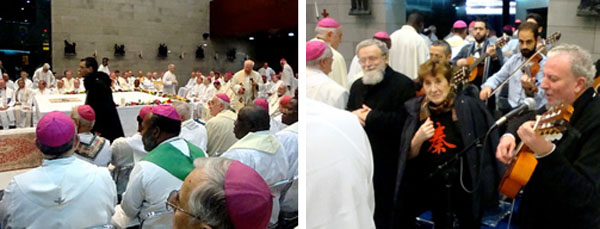
A large group of Prelates and priests are introduced to the neocatechumenate on a trip to Israel where their presence is large; Kiko and Carmen greet them after the 'ceremony'
|
1. Pope’s Address to Neocatechumenal Way, Zenit, November 20, 2012
2. Ibid.
3. Il neocatecumenato. Un’iniziazione cristiana per adulti, with an introduction by no Cardinal Paul Josef Cordes, Naples, Chirico, 2004, pp. 71-77. Cited in “‘Placet’ or ‘Non placet’? The wager of Carmen and Kiko” Chieso Espresso online, Jan 13, 2012
4. Wikipedia, Redemptoris Mater
5. Wikipedia, The Neocatechumenal Way
6. Neocatechumenal Way website, Discourses of the Popes,Salt of the Earth,
7. “Pope: ‘The Lord confirms the Neocatechumenal Way,’” Zenit, January 17, 2011.

Posted January 25, 2012

Related Topics of Interest
 Card. Ratzinger Gives Communion to Protestant Schutz Card. Ratzinger Gives Communion to Protestant Schutz
 Schutz Did Not Convert from Protestantism Schutz Did Not Convert from Protestantism
 Benedict at the Lutheran Temple in Rome Benedict at the Lutheran Temple in Rome
 Ratzinger with Heretics Yesterday and Today Ratzinger with Heretics Yesterday and Today
 Benedict Praises Religious Syncretism Benedict Praises Religious Syncretism
 The 'Catholic' Charismatic Movement Is Not Catholic The 'Catholic' Charismatic Movement Is Not Catholic
 The ‘Poor Pope Benedict’ Syndrome The ‘Poor Pope Benedict’ Syndrome
 Muslim-Style Adoration for Catholic Children Muslim-Style Adoration for Catholic Children

 |
Talks with Jan | Religious | Home | Books | CDs | Search | Contact Us | Donate

© 2002-
Tradition in Action, Inc. All Rights Reserved
|
 |
|